#027: Gilled Mushrooms (Agarics)
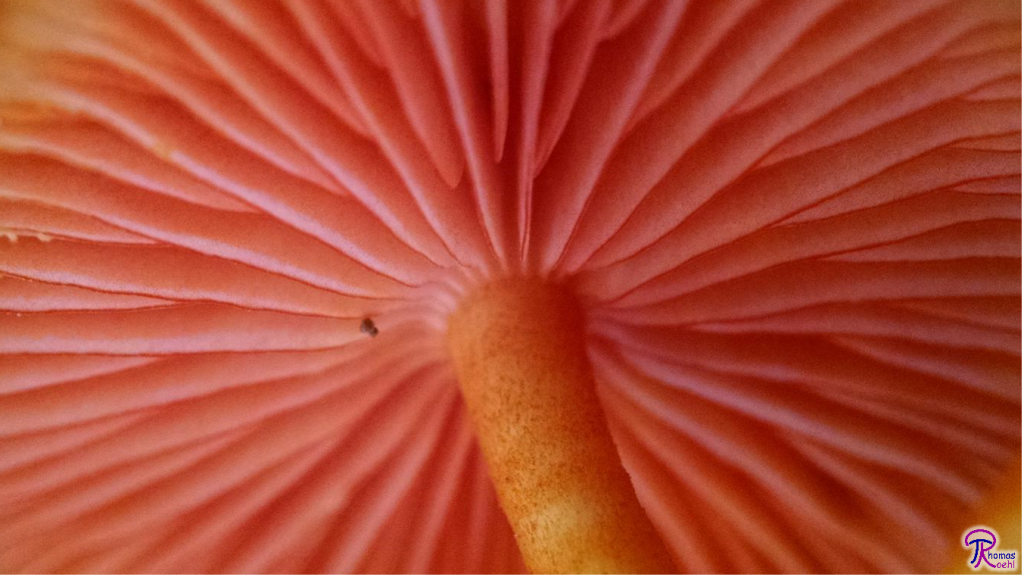
Agarics develop distinctive gill-like plates of spore-producing tissue. Mycena leaiana, pictured, can be distinguished by its red gill margins.
The gilled mushrooms, informally referred to as ‘agarics,’ are the type of mushroom with which we are most familiar. The most common edible mushrooms (white/button/portabella mushrooms, oyster mushrooms, and shiitake mushrooms), Amanita muscaria – the most recognizable mushroom in the world and the inspiration for almost all mushroom art – and the ‘magic mushrooms’ are all gilled mushrooms. All these mushrooms share one feature: vertical plates of spore-producing tissue stacked under a sterile cap.1–5
Morphology
Gilled mushrooms are amazingly diverse. If you look at a field guide, chances are at least half of it will be devoted to agarics. What makes these organisms so successful? A large part of it is probably due to their gills. Gills (known to mycologists as ‘lamellae’) are plates of spore-producing tissue that form perpendicular to an upper sterile cap (called a ‘pileus’) and radiate out from a single point. The shape of these plates of tissue is reminiscent of fish gills, which resulted in the term ‘gills’. Gills are very efficient at increasing the surface area of the hymenium, which means the mushroom can produce more spores and give itself a higher chance of reproducing successfully.>1
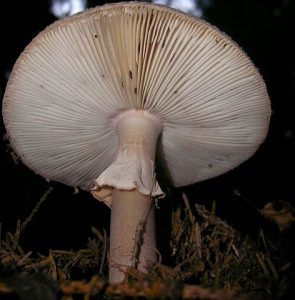
Amanita rubescens is a typical agaric, with gills, a pileus, and a central stipe. Photo by Danny Steaven S. [CC BY-SA 3.0], via Wikimedia Commons
Some mushrooms, like the oyster mushroom, do not form a stipe or, if they do, it is small and lateral. These mushrooms have a ‘pleurotoid’ morphology (named for the oyster mushroom, Pleurotus ostreatus).>6 In pleurotoid mushrooms, the gills radiate from the point at which the mushroom is attached to the wood. These mushrooms do not need a stipe because they are usually found growing on logs and are thus already elevated above the static layer of air.
Other variations on the agaric morphology include the color, shape, texture, decorations, and developmental strategy of the gills, pileus, and stipe. All of those differences as well as the ones mentioned above are useful in identifying agaric species. Microscopic characters can also be good diagnostics; the most important of these is the spore color, which can be assessed macroscopically by taking a spore print.
The chart below summarizes the key differences between 17 of the most commonly encountered groups of agarics. Blank cells mean that the feature is variable within the group and/or not important for identification.
| Group | Spore Color | Gill Attachment | Veils | Ecology | Unique Characteristics
|
|---|---|---|---|---|---|
| Amanita6-9 | white | free
Free gills approach but do not touch the stipe.
|
partial veil universal veil
The partial veil is a membrane that extends from the stipe to the pileus margin and serves to protect the developing gills.
The universal veil is a membrane that completely surrounds the outside of a developing mushroom.
|
mycorrhizal
Mycorrhizal fungi form mutualistic associations with plant roots: the fungus provides the root with hard-to-get nutrients like phosphorous and nitrogen in exchange for sugars the plant produced through photosynthesis.
|
schizohymenial growth
During schizohymenial growth, the gills forcibly break away from the surrounding tissue. This type of growth can be distinguished because no basidia form on the edges of the gills.
|
| Lepiotoid10,11 | white | free | partial veil
no universal veil |
saprobic, terrestrial
Saprobic organisms extract energy from their surroundings by secreting digestive enzymes.
|
disorganized lamellar trama (useful only to separate from Amanita)
The lamellar trama is the mycelial tissue between the gill faces. Assessing the organization of the hyphae there is useful during identification
|
| Russula11-13 | white or light-colored | attached
Attached gills meet the stipe but do not run down it.
|
mycorrhizal | crumbly flesh | |
| Lactarius14-16 | white or light-colored | attached | mycorrhizal | exuding milky latex | |
| Waxy Caps11 | white | attached to decurrent | waxy gills | ||
| Pleurotoid11,17,18 | white to off-white (or brown in Crepidotus) | stipe absent or short and lateral | |||
| Tricholomatoid19 | white or whitish | not in other groups | |||
| Agaricus20 | chocolate-brown | free | partial veil | saprobic, terrestrial | pileus easily separates from stipe |
| Stropharioid11,21 | brown to dark brown | attached | partial veil | saprobic on wood, dung, litter | smooth spores with germ pore, filamentous cap surface |
| Cortinarius22-24 | brown | cortinous partial veil
A cortinous partial veil or cortina is a cobweb-like membrane that covers and protects the developing gills.
|
mycorrhizal | often enlarged base | |
| Crepidotus25,26 | brown | saprobic on wood | stipe absent or rudimentary | ||
| Coprinoid11,27,28 | black to purple-brown | saprobic | deliquescent gills or (for Psathyrella) a stipe that easily snaps in half
Deliquescent: liquefying
|
||
| Bolbitiaceae11 | brown to yellow | saprobic on litter, dung | cellular cap surface
A cellular tissue is composed of rounded cells rather than filamentous cells.
|
||
| Paxillaceae11 | brown | decurrent | saprobic on wood, mycorrhizal | flesh green in FeSO4 | |
| Gomphidiaceae29,30 | black to gray | decurrent to attached | mycorrhizal with pines | young mushrooms shaped like tent pegs | |
| Pluteaceae31,32 | pink | free | [Volvariella: universal veil] | saprobic on wood or litter | |
| Entolomataceae33,34 | pink | attached | saprobic on litter or wood, mycotrophic on mushrooms | angular spores
Angular spores are composed of multiple sharp angles.
|
If you want to speed up your identification in the field, you should memorize this chart. Actually, developing an intuitive sense for what kinds of mushrooms belong to which group is more helpful, but that takes years of identification practice. Until then, use this chart to help you decide on a starting point for identification. The list above is hardly exhaustive; many more groups of agarics exist, but those are generally less common.
Taxonomy
One reason that there is so much variability within this morphological group of mushrooms is because gills have evolved independently multiple times. Gilled mushrooms are all basidiomycetes (see FFF#013), but the morphological group is polyphyletic. At this point it is important to note that the terms “gilled mushrooms,” “agarics,” and “pleurotoid” do not really have any taxonomic meaning. Instead, they are informal terms that refer to a diverse group of mushrooms that happen to look similar. They are useful, however, in field guides and to help with mushroom identification.1
Most agarics belong to the order Agaricales. Gills also evolved in the orders Russulales, (see FFF#028), and Polyporales (see FFF#030), although these have not diversified nearly as much as the Agaricales. All these orders contain fungi with gills indistinguishable from Agaricales gills. However, the Boletales and Polyporales also have some mushrooms with gills that are not quite so well formed. For example, Phylloporus rhodoxanthus (FFF#187) and Lenzites betulina (FFF#168) are known as the “Gilled Bolete” and the “Gilled Polypore,” respectively. Neither one looks quite enough like the rest of the agarics to hide their taxonomic affiliations. In both cases, the mushrooms are considered to have ‘false gills’. The order Cantharellales (see FFF#029) has also produced species with well-developed, gill-like ridges, although these are blunted and therefore also considered false.11
All the orders with true gilled mushrooms also contain mushrooms with other, simpler morphologies.35 This indicates that they did not all derive from a gilled common ancestor and must therefore have evolved gills have evolved independently of one another. This must have happened at least four times, but likely more than that. I suspect that the Agaricales were the first to evolve gills, since that order contains the greatest number and the most diverse group of agarics.
All agarics belong to the kingdom Fungi, division Basidiomycota, subdivision Agaricomycotina, and class Agaricomycetes. The table below lists some of the most common agaric genera by taxonomic divisions. This chart does not show you which families or genera are most closely related to one another, but it should give you an idea of the genetic diversity found in gilled mushrooms.
| order | family | genus38 | group(s)11 |
|---|---|---|---|
| Agaricales | Agaricaceae | Agaricus | agaricus |
| Chlorophyllum | lepiotoid | ||
| Coprinus | coprinoid | ||
| Lepiota | lepiotoid | ||
| Macrolepiota | |||
| Amanitaceae | Amanita | amanita | |
| Bolbitiaceae | Bolbitius | bolbitiaceae | |
| Cortinariaceae | Cortinarius | cortinarius | |
| Entolomataceae | Entoloma | entolomataceae | |
| Hygrophoraceae | Hygrocybe | waxy cap | |
| Hygrophorous | |||
| Hymenogastraceae | Psilocybe | stropharioid | |
| Inocybaceae | Cortinarius | cortinarius, pleurotoid | |
| Marasmiaceae | Marasmius | tricholomatoid | |
| Pleurocybella | pleurotoid | ||
| Mycenaceae | Mycena | tricholomatoid | |
| Panellus | pleurotoid | ||
| Omphalotaceae | Omphalotus | tricholomatoid | |
| Physalariaceae | Armillaria | tricholomatoid | |
| Pleurotaceae | Pleurotus | pleurotoid | |
| Pluteaceae | Pluteus | pluteaceae | |
| Volvariella | |||
| Psathyrellaceae | Coprinellus | coprinoid | |
| Coprinopsis | |||
| Panaeolus | |||
| Parasola | |||
| Psathyrella | |||
| Schizophyllaceae | Schizophyllum | pleurotoid | |
| Strophariaceae | Deconica | stropharioid | |
| Hypholoma | |||
| Pholiota | |||
| Stropharia | |||
| Tricholomataceae | Camarophyllopsis | waxy cap | |
| Clitocybe | tricholomatoid | ||
| Collybia | |||
| Omphalina | |||
| Resupinatus | pleurotoid | ||
| Tricholoma | tricholomatoid | ||
| Boletales | Gomphidiaceae | Chroogomphus | gomphidiaceae |
| Gomphidius | |||
| Paxillaceae | Paxillus | paxillaceae, pleurotoid | |
| Polyporales | Polyporaceae | Panus | pleurotoid |
| Russulales | Auriscalpaceae | Lentinellus | pleurotoid |
| Russulaceae | Lactarius | lactarius, pleurotoid | |
| Lactifluus | |||
| Multifurca | |||
| Russula | russula |
This post describes a group of mushrooms and as such the information on this page (including the pictures) cannot be used to identify any mushroom in particular.
This post does not contain enough information to positively identify any mushroom. When collecting for the table, always use a local field guide to identify your mushrooms down to species. If you need a quality, free field guide to North American mushrooms, I recommend Michael Kuo’s MushroomExpert.com. Remember: when in doubt, throw it out!
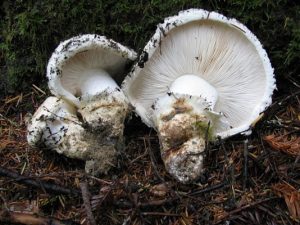
The tricholomatoid fungi, which include this Tricholoma magnivelare, are a hodgepodge group of mushrooms that don’t fit in the other main agaric lineages. Photo by Ryane Snow (snowman) [CC BY-SA 3.0], via Wikimedia Commons
Tricholomatoid
These mushrooms used to be collected in an enormous family called Tricholomataceae. This family was the dumping ground for all the white-spored mushrooms that mycologists couldn’t decide where to put. As you might guess, DNA evidence is tearing this family to shreds. While the mushrooms will remain in the order Agaricales, mycologists have had to establish numerous new families to account for the extreme diversity of the tricholomatoid mushrooms. Many genera still remain in Tricholomataceae, but it seems likely that in a few decades the only genus left there will be Tricholoma.11,19
Morphologically, the tricholomatoid mushrooms have only two things in common: 1) they have white or pale spore prints and 2) they do not belong to another group. Despite this lack of similarity, field guide authors continue to use the tricholomatoid group because it allows them to separate these fungi from all the other morphologically distinct groups of pale-spored agarics. The general strategy is this: make sure your mushroom doesn’t belong to Amanita, Russula, etc. before tackling the trichalomatoid mushrooms.11,19
Unsurprisingly, tricholomatoid mushrooms have many different nutritional strategies and preferred habitats. Additionally, the group contains both edible and poisonous species.11,19
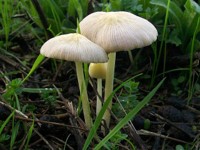
The Bolbitiaceae include fragile mushrooms with light brown spores, such as this Bolbitius reticulans. Photo by AnemoneProjectors [CC BY-SA 2.0], via Wikimedia Commons
Bolbitiaceae
Except for their brown to yellow spore colors, the Bolbitiaceae Singer36 look for all the world like small coprinoid mushrooms. The stature and thin flesh are reminiscent of mushrooms in the genus Coprinopsis, but the small mushrooms in Bolbitiaceae do not have deliquescent gills and produce spores much lighter in color. Additionally, the surface of the pileus in Bolbitaceae mushrooms is composed of circular cells (‘cellular’) whereas the coprinoid mushrooms have a filamentous cap surface. The two main genera in the Bolbitiaceae are Bolbitius and Conocybe. Both contain small and relatively uninteresting species. Bolbitius mushrooms are nontoxic but inedible due to their size while Conocybe mushrooms contain hallucinogens and amatoxins (FFF#091) and so should be avoided.11
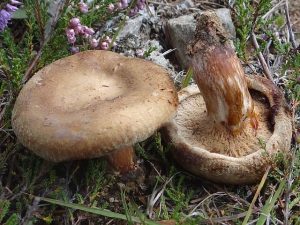
The Paxillaceae produce mushrooms with brown spores, decurrent gills and inrolled margins. Photo of Paxillus involutus by Selso [CC BY-SA 3.0], via Wikimedia Commons
Paxillaceae
Paxillaceae Lotsy37 is related to the boletes and contains agarics with a yellow-brown to clay colored spore print, decurrent gills, an inrolled margin, and flesh that stains green in ferric sulphate. Some of the mushrooms in the group lack a stipe and therefore can be considered pleurotoid. The Paxillaceae most closely resemble either the Gomphidiaceae or species of Crepidotus. Both of those lineages have darker spores, so once you take a spore print it should be an easy matter of separating out the Paxillaceae. Paxillaceae contains both mycorrhizal and saprobic species, so the mushrooms appear on wood as well as on the ground. Mushrooms in Paxillus produce gastrointestinal irritants and are therefore considered poisonous.11
The Fungus Fact Friday Agarics Pages:
#178: The Family Gomphidiaceae
Citations
- Kuo, M. The Gilled Mushrooms (‘Agaricales’). MushroomExpert.Com (2007). Available at: http://www.mushroomexpert.com/agaricales.html. (Accessed: 5th May 2017)
- Kuo, M. Agaricus bisporus: The Button Mushroom. MushroomExpert.Com (2004). Available at: http://www.mushroomexpert.com/agaricus_bisporus.html. (Accessed: 5th May 2017)
- Kuo, M. Pleurotus ostreatus: The Oyster Mushroom. MushroomExpert.Com (2005). Available at: http://www.mushroomexpert.com/pleurotus_ostreatus.html. (Accessed: 5th May 2017)
- Volk, T. J. Tom Volk’s Fungus of the Month for December 1999. Tom Volk’s Fungi (1999). Available at: http://botit.botany.wisc.edu/toms_fungi/dec99.html. (Accessed: 5th May 2017)
- Wood, M. & Stevens, F. California Fungi—Psilocybe cyanescens. The Fungi of California Available at: http://www.mykoweb.com/CAF/species/Psilocybe_cyanescens.html. (Accessed: 5th May 2017)
- Kuo, M. Oysters: Pleurotoid Mushrooms. MushroomExpert.Com (2005). Available at: http://www.mushroomexpert.com/pleurotoid.html. (Accessed: 5th May 2017)
- The Journal of Wild Mushrooming (2014).
- Michael Kuo. The Genus Amanita. MushroomExpert.Com (2013). Available at: http://www.mushroomexpert.com/amanita.html. (Accessed: 6th January 2017)
- RE Tulloss. About Amanita. Studies in the Amanitaceae (2017). Available at: http://www.amanitaceae.org/?About%20Amanita. (Accessed: 6th January 2017)
- Michael Kuo. Lepiotoid Mushrooms. MushroomExpert.Com (2015). Available at: http://www.mushroomexpert.com/lepiotoid.html. (Accessed: 13th January 2017)
- Miller, O. K. & Miller, H. North American mushrooms: a field guide to edible and inedible fungi. (Falcon Guide, 2006).
- Thomas J. Volk. Tom Volk’s Fungus of the Month for September 2004. Tom Volk’s Fungi (2004). Available at: http://botit.botany.wisc.edu/toms_fungi/sep2004.html. (Accessed: 27th January 2017)
- Benjamin Woo. Trial field key to the species of RUSSULA in the Pacific Northwest. Pacific Northwest Key Council (1989). Available at: http://www.svims.ca/council/Russul.htm. (Accessed: 27th January 2017)
- Michael Kuo. The Genus Lactarius. MushroomExpert.Com (2011). Available at: http://www.mushroomexpert.com/lactarius.html. (Accessed: 3rd February 2017)
- Coleman S. Leuthy. Key to species of LACTARIUS in the Pacific Northwest. Pacific Northwest Key Council (1997). Available at: http://www.svims.ca/council/Lactar.htm. (Accessed: 3rd February 2017)
- Thomas J. Volk. Tom Volk’s Fungus of the Month for June 2000. Tom Volk’s Fungi (2000). Available at: http://botit.botany.wisc.edu/toms_fungi/june2000.html. (Accessed: 3rd February 2017)
- Kuo, M. Oysters: Pleurotoid Mushrooms. MushroomExpert.Com (2005). Available at: http://www.mushroomexpert.com/pleurotoid.html. (Accessed: 10th March 2017)
- Brown, D. E. Trial field key to the PLEUROTOID SPECIES in the Pacific Northwest. Pacific Northwest Key Council (2003). Available at: http://www.svims.ca/council/Pleuro.htm. (Accessed: 10th March 2017)
- Kuo, M. The Tricholomataceae. MushroomExpert.Com (2004). Available at: http://www.mushroomexpert.com/tricholomataceae.html. (Accessed: 5th May 2017)
- Michael Kuo. The Genus Agaricus. MushroomExpert.Com (2007). Available at: http://www.mushroomexpert.com/agaricus.html. (Accessed: 19th January 2017)
- Kroeger, P. Trial Keys to purple to blackish spored STROPHARIACEAE of British Columbia, Canada. Pacific Northwest Key Council (2009). Available at: http://www.svims.ca/council/Stroph.htm. (Accessed: 14th April 2017)
- Kuo, M. The Genus Cortinarius. MushroomExpert.Com (2011). Available at: http://www.mushroomexpert.com/cortinarius.html. (Accessed: 28th April 2017)
- Gibson, I. Notes on CORTINARIUS in the Pacific Northwest. Pacific Northwest Key Council (2017). Available at: http://www.svims.ca/council/Cortin.htm. (Accessed: 28th April 2017)
- Cortinarius Genus. Great Lakes Nexus Page of Mushroom, The Journal of Wild Mushrooming Available at: http://www.mushroomthejournal.com/greatlakesdata/Taxa/CortiGenus42.html. (Accessed: 28th April 2017)
- Volk, T. J. & Palmer, J. Crepidotus crocophyllus, the orange crep. – Tom Volk’s Fungus of the Month for July 2007. Tom Volk’s Fungi (2007). Available at: http://botit.botany.wisc.edu/toms_fungi/jul2007.html. (Accessed: 3rd March 2017)
- Gibson, I. Notes on CREPIDOTUS in the Pacific Northwest. Pacific Northwest Key Council (2007). Available at: http://www.svims.ca/council/Crepid.htm. (Accessed: 3rd March 2017)
- Michael Kuo. Coprinoid Mushrooms: The Inky Caps. MushroomExpert.Com (2008). Available at: http://www.mushroomexpert.com/coprinoid.html. (Accessed: 10th February 2017)
- Michael Kuo. The Genus Psathyrella. MushroomExpert.Com (2011). Available at: http://www.mushroomexpert.com/psathyrella.html. (Accessed: 10th February 2017)
- Scates, K. Field key to GOMPHIDIACEAE in the Pacific Northwest. Pacific Northwest Key Council (2017). Available at: http://www.svims.ca/council/Gomphi.htm. (Accessed: 16th February 2017)
- Miller, O. K. The Gomphidiaceae Revisited: A Worldwide Perspective. Mycologia 95, 176–183 (2003).
- Kuo, M. The Genus Pluteus. MushroomExpert.Com (2015). Available at: http://www.mushroomexpert.com/pluteus.html. (Accessed: 7th April 2017)
- Kuo, M. The Genus Volvariella. MushroomExpert.Com (2011). Available at: http://www.mushroomexpert.com/volvariella.html. (Accessed: 7th April 2017)
- Ramsey, R. W. ENTOLOMATACEAE in the Pacific Northwest. Pacific Northwest Key Council (2003). Available at: http://www.svims.ca/council/Entolo.htm. (Accessed: 31st March 2017)
- Kuo, M. Entolomatoid Mushrooms. MushroomExpert.Com (2013). Available at: http://www.mushroomexpert.com/entoloma.html. (Accessed: 31st March 2017)
- Kuo, M. Mushroom Taxonomy. MushroomExpert.Com (2014). Available at: http://www.mushroomexpert.com/taxonomy.html. (Accessed: 5th May 2017)
- Mycobank Available at: http://www.mycobank.org/Biolomics.aspx?Table=Mycobank&Rec=92707&Fields=All. (Accessed: 5th May 2017)
- Mycobank Available at: http://www.mycobank.org/Biolomics.aspx?Table=Mycobank&Rec=58928&Fields=All. (Accessed: 5th May 2017)
- MycoBank Database. Mycobank Available at: http://www.mycobank.org/. (Accessed: 5th May 2017)

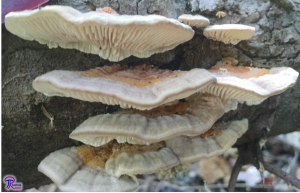

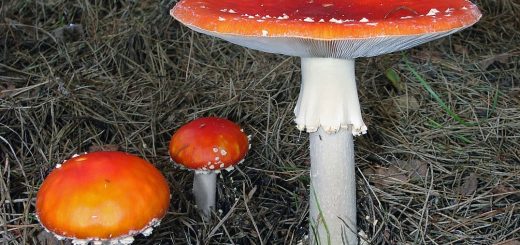





![#011: Characteristics of Kingdom Fungi [Archived]](https://www.fungusfactfriday.com/wp-content/themes/hueman/assets/front/img/thumb-small-empty.png)

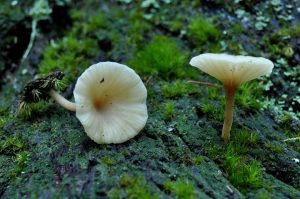
4 Responses
[…] boletes,7 which explains why the three lineages produce mushrooms that look alike. In Paxillus (see FFF#027), the gills are easily peeled away from the pileus in a single layer.3 This feature is common among […]
[…] mushrooms should learn to identify this group. In general, amanitas are umbrella-shaped agarics (FFF#027) that usually display all the following features: a universal veil, a partial veil, free gills, and […]
[…] Agaricales […]
[…] Agaricales […]